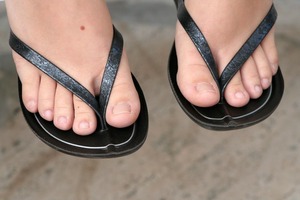It doesn’t hurt or harm your health, but ladies: your toes may not look so pretty in your summer sandals. Toenail fungal infection, also known as onychomycosis, is a common condition, mostly seen in older adults. The nail becomes thickened, with a yellow or black appearance. The nails become brittle and rough with ragged edges. And there is usually no pain unless the disease is severe.
As I started peeling off the sneakers and socks from winter, I noticed a slight tinge of yellow on my big toes. Now, I could cover them with a coat of bright nail polish, but let’s face it – if there is a fungus there, the best thing is to let my nails breathe and seek treatment.
In a healthy person, fungus is usually caught from areas that are wet and moist. Gym showers or community swimming pools and spas are common places. Even wearing closed shoes with sweaty feet can wreak havoc on the nails. Feet need to breathe! Other people with underlying diseases such as autoimmune disorders, diabetes, cancer, or weakened immune systems can become infected with a toenail fungus easily.
Natural Remedies to Treat Toenail Fungus
- Keep your nails short. Long toenails act like little levers that can lift and invite the fungus inside.
- Keep your feet free of dead skin. Fungus will attract to this dry skin and then works it way to infect good areas. Gently exfoliate dead skin buildup with a nailbrush, soap and water.
- Use a hairdryer on your feet to keep them dry. Blow cool air under, around and between the toes after bathing.
- Wear breathable shoes. Real leather and even canvas is breathable, which is so important to keep nails healthy. Beware of vinyl shoes. It’s even better to switch shoes from day to day, so they are completely dry from moisture. Even socks should be all cotton. At home, I exchange my shoes for flip-flops so my feet can take a breath of fresh air.
How a Doctor Can Help
Doctors, preferably a podiatrist, can give you medication or treatments that can help rid the nail fungus and get you on the way to pretty feet.
There are topical medicines, such as Penlac or Nailstat to treat nail fungus. Topical treatments have fewer side effects and do not interact with other drugs. I find Nailstat works for me and has a pleasant scent. The only downfall is that it takes a long time to clear, sometimes up to a year.
For severe cases, doctors may order oral medications such as Sporanox or Lamisil. Watch out for changes in liver enzymes. Anyone on this type treatment should be under a doctor’s care and have appropriate blood testing periodically.
Laser treatments use a specified wavelength of laser light to target and kill the fungus. This method only kills the fungus and leaves the nail and skin as is. This treatment is said to be safe, painless and effective.
Sources:
Personal experience and advice from my podiatrist
Kirchheimer, Sid: The Doctor’s Book of Home Remedies; Rodale Press, 1993
Nail Fungus
More from this contributor:
What’s This on My Skin? Women’s Dermatologic Conditions
How to Live with Unsightly and Annoying Varicose Veins
Interstitial Cystitis: Remedies for Comfort


